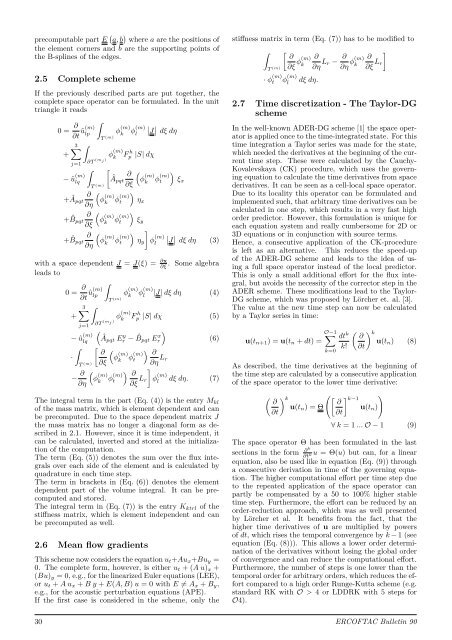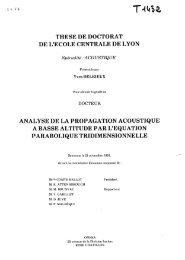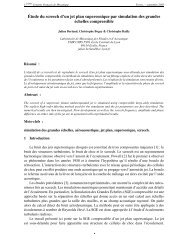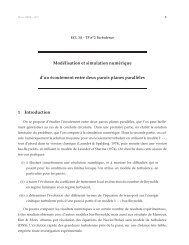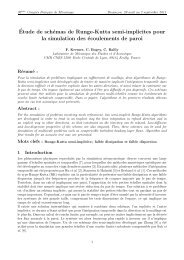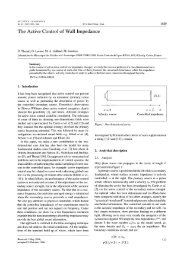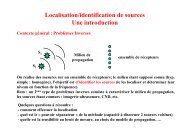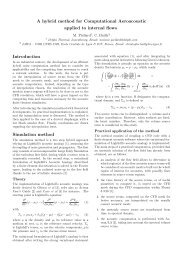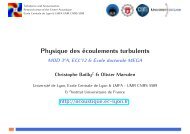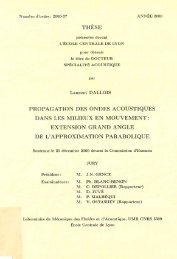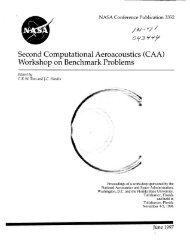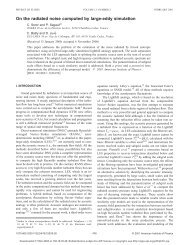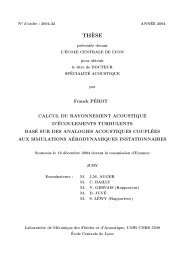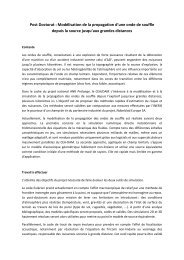ERCOFTAC Bulletin - Centre Acoustique
ERCOFTAC Bulletin - Centre Acoustique
ERCOFTAC Bulletin - Centre Acoustique
You also want an ePaper? Increase the reach of your titles
YUMPU automatically turns print PDFs into web optimized ePapers that Google loves.
precomputable part E a, b where a are the positions of<br />
the element corners and b are the supporting points of<br />
the B-splines of the edges.<br />
2.5 Complete scheme<br />
If the previously described parts are put together, the<br />
complete space operator can be formulated. In the unit<br />
triangle it reads<br />
0 = ∂<br />
∂t û(m)<br />
<br />
lp φ (m)<br />
k φ(m)<br />
<br />
<br />
l J dξ dη<br />
+<br />
3<br />
<br />
j=1<br />
− û (m)<br />
lq<br />
∂T (m j )<br />
<br />
+ Âpqt<br />
∂<br />
∂η<br />
+ ˆ ∂<br />
Bpqt<br />
∂ξ<br />
+ ˆ ∂<br />
Bpqt<br />
∂η<br />
T (m)<br />
<br />
φ (m)<br />
k F h p |S| dχ<br />
∂<br />
∂ξ<br />
<br />
T (m)<br />
Âpqt<br />
<br />
φ (m)<br />
k φ(m) t<br />
<br />
φ (m)<br />
k φ(m) t<br />
<br />
φ (m)<br />
k φ(m) t<br />
<br />
<br />
<br />
φ (m)<br />
k φ(m)<br />
<br />
t ξx<br />
ηx<br />
ξy<br />
ηy<br />
<br />
φ (m) <br />
J l<br />
dξ dη (3)<br />
with a space dependent J = J(ξ) = ∂x<br />
∂ξ . Some algebra<br />
leads to<br />
0 = ∂<br />
∂t û(m)<br />
<br />
lp<br />
3<br />
<br />
+<br />
j=1<br />
∂T (m j )<br />
T (m)<br />
φ (m)<br />
k φ(m)<br />
l |J| dξ dη (4)<br />
φ (m)<br />
k F h p |S| dχ (5)<br />
− û (m)<br />
<br />
lq<br />
Âpqt E y r − ˆ Bpqt E x <br />
r<br />
(6)<br />
<br />
·<br />
T (m)<br />
<br />
∂<br />
<br />
φ<br />
∂ξ<br />
(m)<br />
k φ(m)<br />
<br />
∂<br />
t<br />
∂η Lr<br />
− ∂<br />
<br />
φ<br />
∂η<br />
(m)<br />
k φ(m)<br />
<br />
∂<br />
t<br />
∂ξ Lr<br />
<br />
φ (m)<br />
l dξ dη. (7)<br />
The integral term in the part (Eq. (4)) is the entry Mkl<br />
of the mass matrix, which is element dependent and can<br />
be precomputed. Due to the space dependent matrix J<br />
the mass matrix has no longer a diagonal form as described<br />
in 2.1. However, since it is time independent, it<br />
can be calculated, inverted and stored at the initialization<br />
of the computation.<br />
The term (Eq. (5)) denotes the sum over the flux integrals<br />
over each side of the element and is calculated by<br />
quadrature in each time step.<br />
The term in brackets in (Eq. (6)) denotes the element<br />
dependent part of the volume integral. It can be precomputed<br />
and stored.<br />
The integral term in (Eq. (7)) is the entry Kktrl of the<br />
stiffness matrix, which is element independent and can<br />
be precomputed as well.<br />
2.6 Mean flow gradients<br />
This scheme now considers the equation ut+Aux+Buy =<br />
0. The complete form, however, is either ut + (A u)x +<br />
(Bu)y = 0, e.g., for the linearized Euler equations (LEE),<br />
or ut + A ux + B y + E(A, B) u = 0 with E = Ax + By,<br />
e.g., for the acoustic perturbation equations (APE).<br />
If the first case is considered in the scheme, only the<br />
stiffness matrix in term (Eq. (7)) has to be modified to<br />
<br />
T (m)<br />
∂<br />
∂ξ φ(m)<br />
k<br />
· φ (m)<br />
t φ (m)<br />
l dξ dη.<br />
∂<br />
∂η Lr − ∂<br />
∂<br />
∂η φ(m)<br />
k ∂ξ Lr<br />
2.7 Time discretization - The Taylor-DG<br />
scheme<br />
In the well-known ADER-DG scheme [1] the space operator<br />
is applied once to the time-integrated state. For this<br />
time integration a Taylor series was made for the state,<br />
which needed the derivatives at the beginning of the current<br />
time step. These were calculated by the Cauchy-<br />
Kovalevskaya (CK) procedure, which uses the governing<br />
equation to calculate the time derivatives from space<br />
derivatives. It can be seen as a cell-local space operator.<br />
Due to its locality this operator can be formulated and<br />
implemented such, that arbitrary time derivatives can be<br />
calculated in one step, which results in a very fast high<br />
order predictor. However, this formulation is unique for<br />
each equation system and really cumbersome for 2D or<br />
3D equations or in conjunction with source terms.<br />
Hence, a consecutive application of the CK-procedure<br />
is left as an alternative. This reduces the speed-up<br />
of the ADER-DG scheme and leads to the idea of using<br />
a full space operator instead of the local predictor.<br />
This is only a small additional effort for the flux integral,<br />
but avoids the necessity of the corrector step in the<br />
ADER scheme. These modifications lead to the Taylor-<br />
DG scheme, which was proposed by Lörcher et. al. [3].<br />
The value at the new time step can now be calculated<br />
by a Taylor series in time:<br />
u(tn+1) = u(tn + dt) =<br />
O−1 <br />
k=0<br />
dt k<br />
k!<br />
<br />
k ∂<br />
u(tn) (8)<br />
∂t<br />
As described, the time derivatives at the beginning of<br />
the time step are calculated by a consecutive application<br />
of the space operator to the lower time derivative:<br />
<br />
k<br />
<br />
k−1<br />
∂<br />
∂<br />
u(tn) = Θ u(tn)<br />
∂t<br />
∂t<br />
∀ k = 1 ... O − 1 (9)<br />
The space operator Θ has been formulated in the last<br />
sections in the form ∂k<br />
∂tk u = Θ(u) but can, for a linear<br />
equation, also be used like in equation (Eq. (9)) through<br />
a consecutive derivation in time of the governing equation.<br />
The higher computational effort per time step due<br />
to the repeated application of the space operator can<br />
partly be compensated by a 50 to 100% higher stable<br />
time step. Furthermore, the effort can be reduced by an<br />
order-reduction approach, which was as well presented<br />
by Lörcher et al. It benefits from the fact, that the<br />
higher time derivatives of u are multiplied by powers<br />
of dt, which rises the temporal convergence by k − 1 (see<br />
equation (Eq. (8))). This allows a lower order determination<br />
of the derivatives without losing the global order<br />
of convergence and can reduce the computational effort.<br />
Furthermore, the number of steps is one lower than the<br />
temporal order for arbitrary orders, which reduces the effort<br />
compared to a high order Runge-Kutta scheme (e.g.<br />
standard RK with O > 4 or LDDRK with 5 steps for<br />
O4).<br />
30 <strong>ERCOFTAC</strong> <strong>Bulletin</strong> 90


